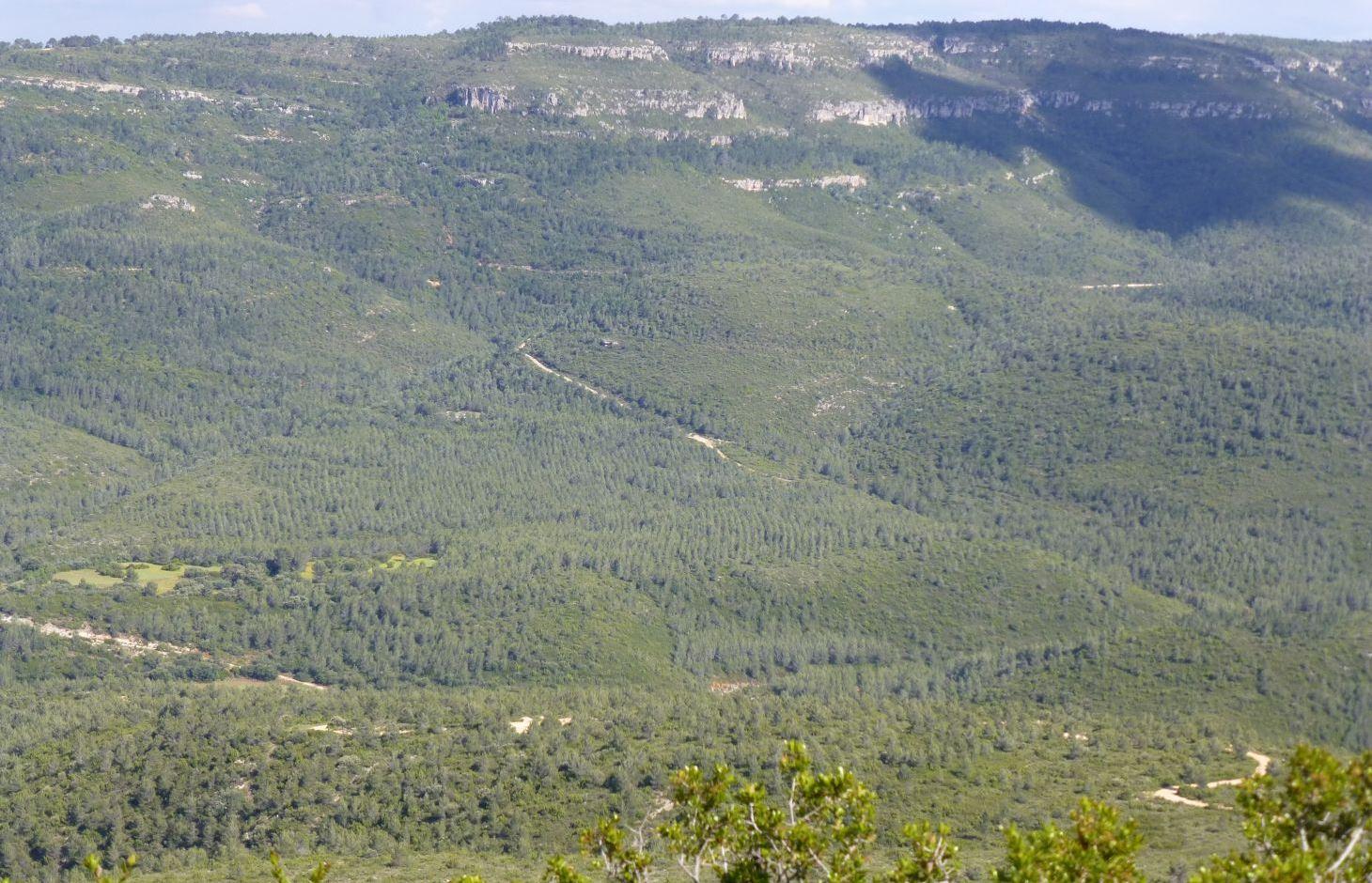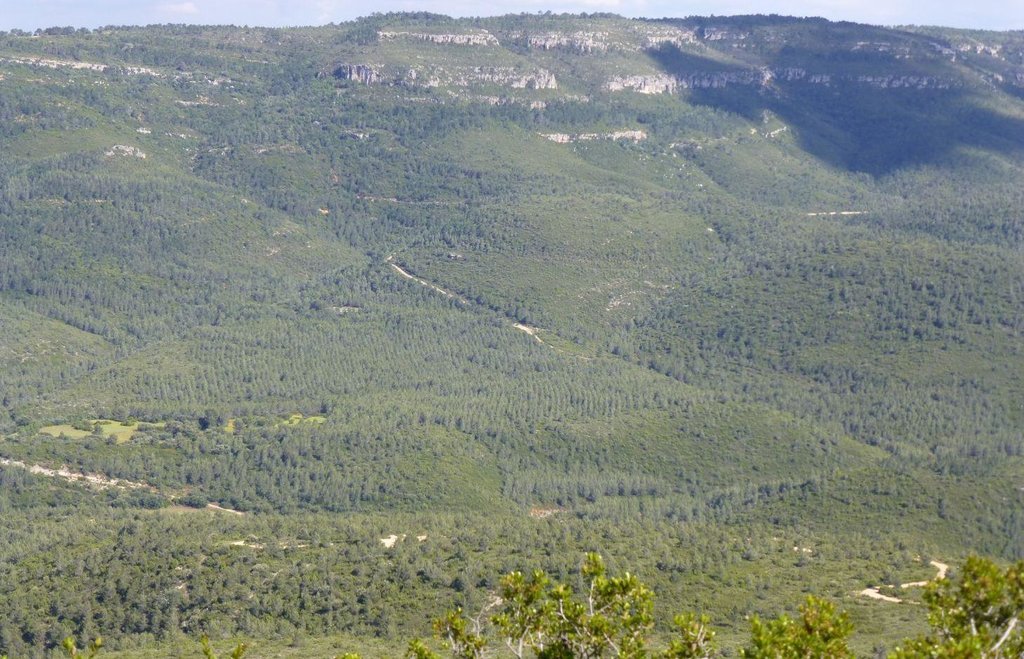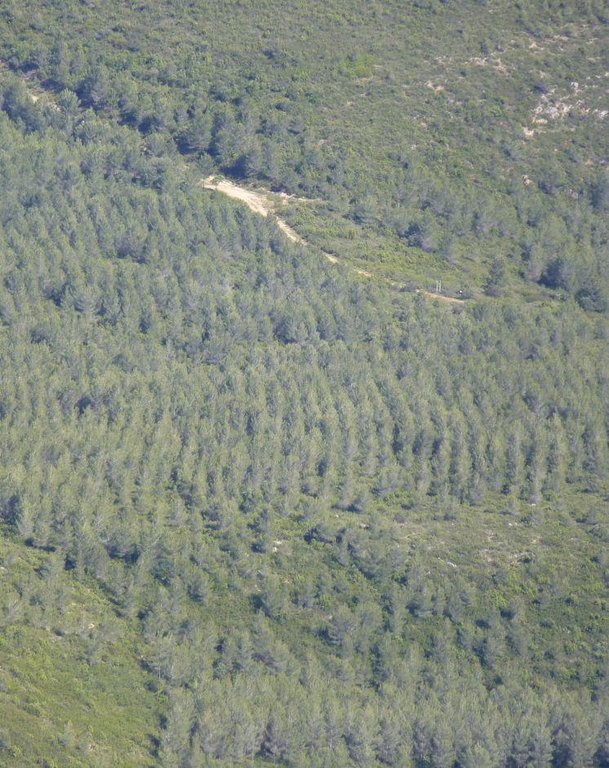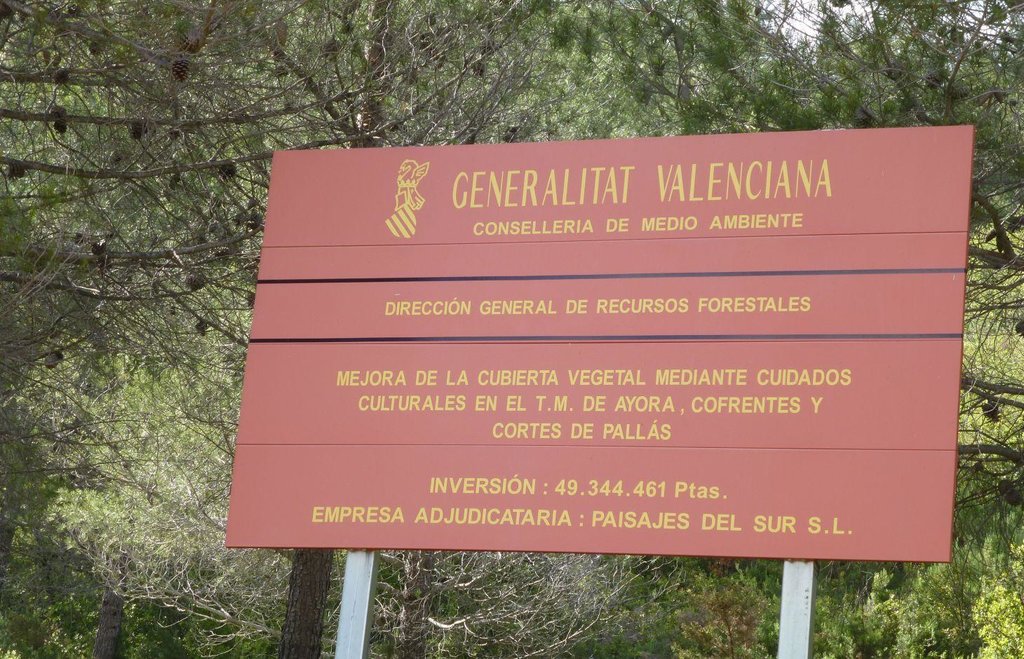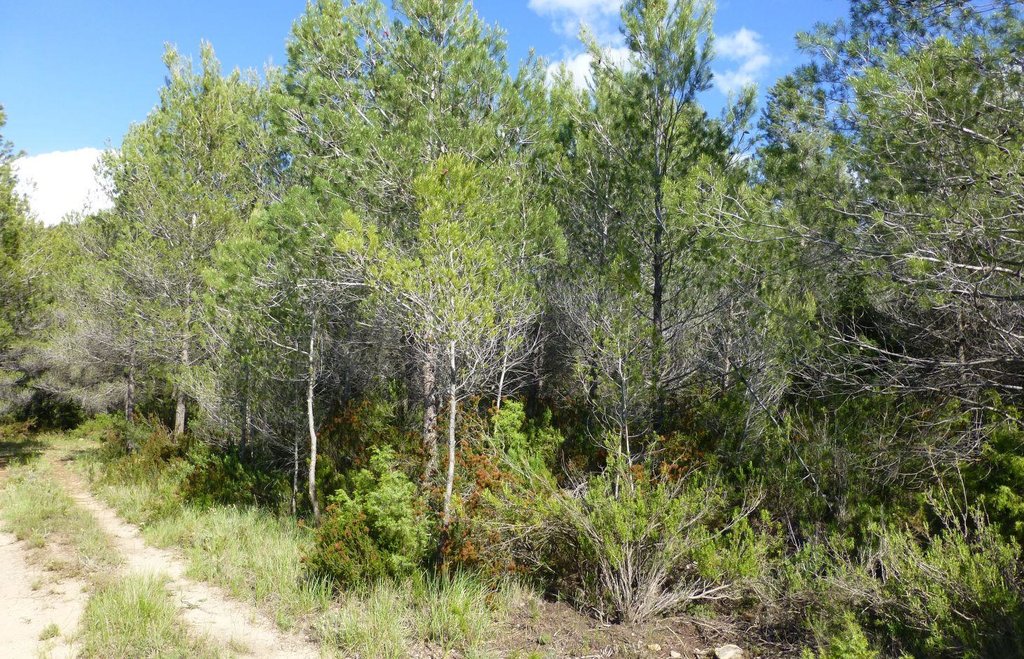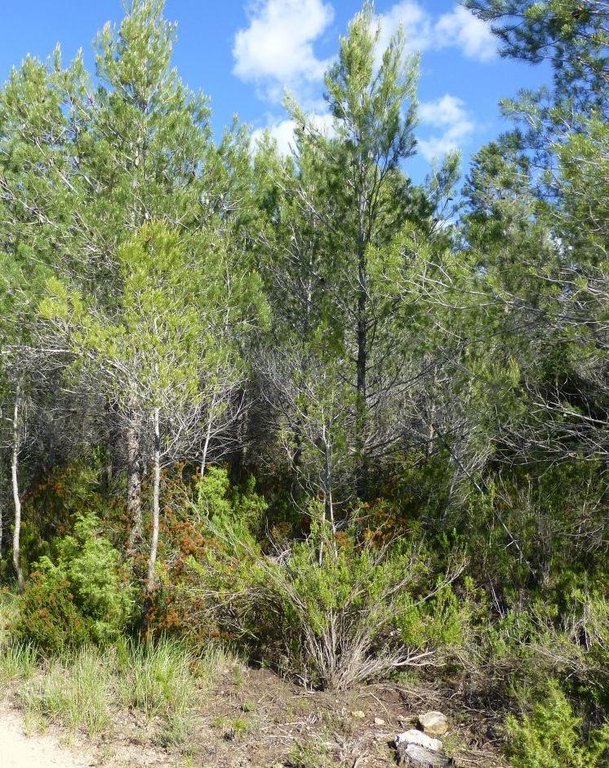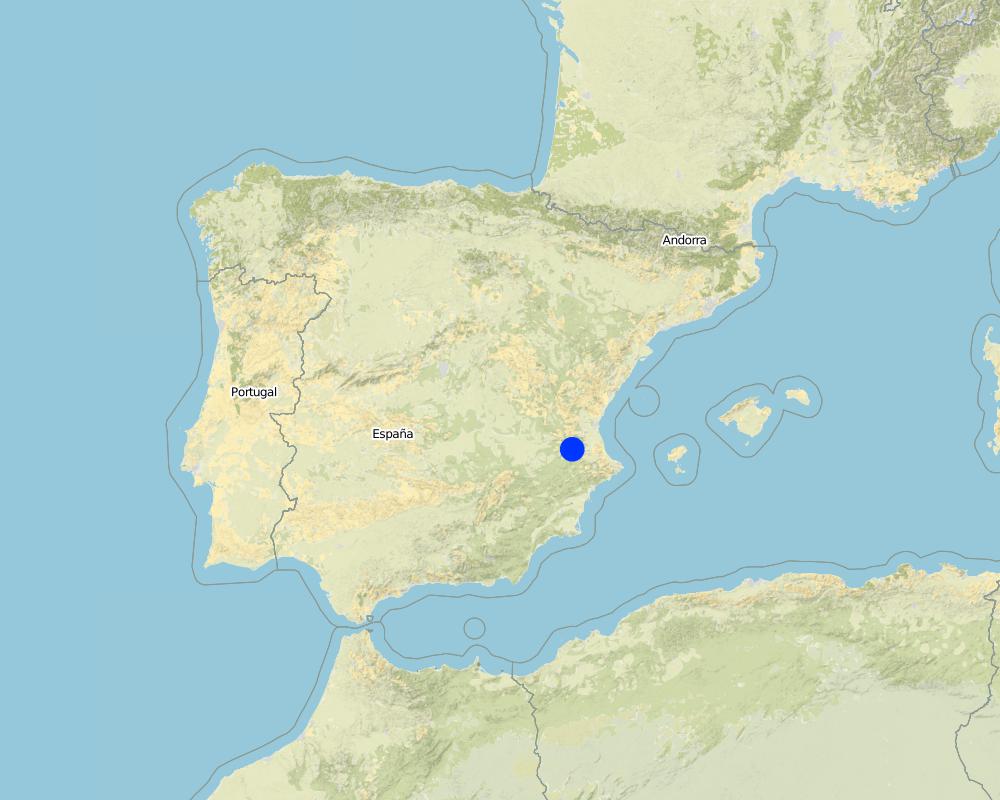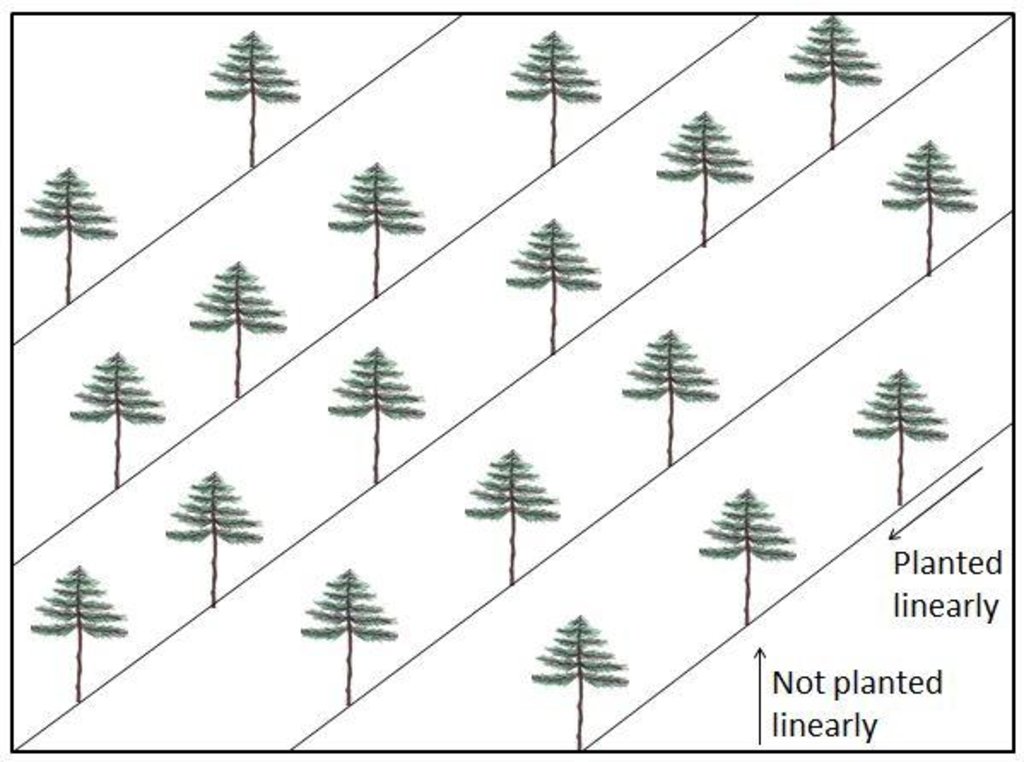Afforestation with Pinus Halepensis after the fire of 1979 (La Molinera) [ប្រទេសអេស្ប៉ាញ]
- ការបង្កើត៖
- បច្ចុប្បន្នភាព
- អ្នកចងក្រង៖ Nina Lauterburg
- អ្នកកែសម្រួល៖ –
- អ្នកត្រួតពិនិត្យច្រើនទៀត៖ Deborah Niggli, Alexandra Gavilano
Repoblación “La Molinera” con Pino Halepensis después del incendio del año 1979 (Spanish)
technologies_1584 - ប្រទេសអេស្ប៉ាញ
- សង្ខេបជា PDF
- សេចក្តីសង្ខេបពេញលេញជាទម្រង់ PDF សម្រាប់បោះពុម្ព
- សេចក្តីសង្ខេបពេញលេញទម្រង់អ៊ីនធឺនេត
- សេចក្តីសង្ខេបពេញលេញ (មិនមានទម្រង់ជាក់លាក់)
- Afforestation with Pinus Halepensis after the fire of 1979 (La Molinera): 3 ខែ មករា ឆ្នាំ 2017 (inactive)
- Afforestation with Pinus Halepensis after the fire of 1979 (La Molinera): 1 ខែ សីហា ឆ្នាំ 2019 (inactive)
- Afforestation with Pinus Halepensis after the fire of 1979 (La Molinera): 1 ខែ ធ្នូ ឆ្នាំ 2021 (public)
ពិនិត្យមើលគ្រប់ផ្នែក
ពង្រីកមើលទាំងអស់ បង្រួមទាំងអស់1. ព័ត៌មានទូទៅ
1.2 ព័ត៌មានលម្អិតពីបុគ្គលសំខាន់ៗ និងស្ថាប័នដែលចូលរួមក្នុងការវាយតម្លៃ និងចងក្រងឯកសារនៃបច្ចេកទេស
អ្នកជំនាញឯកទេស SLM:
Valdecantos Alejandro
Fundación Centro de Estudios Ambientales del Mediterráneo (CEAM)
ប្រទេសអេស្ប៉ាញ
អ្នកជំនាញឯកទេស SLM:
Colomer Vicente
Forest Agent Generalitat Valenciana (Conselleria de infraestructura, territorio y medio ambiente)
ប្រទេសអេស្ប៉ាញ
ឈ្មោះគម្រោងដែលបានចងក្រងឯកសារ/ វាយតម្លៃលើបច្ចេកទេស (បើទាក់ទង)
Catastrophic shifts in drylands (EU-CASCADE)ឈ្មោះអង្គភាពមួយ (ច្រើន) ដែលបានចងក្រងឯកសារ/ វាយតម្លៃបច្ចេកទេស (បើទាក់ទង)
Centro de Estudios Ambientales del Mediterraneo (CEAM) - ប្រទេសអេស្ប៉ាញ1.3 លក្ខខណ្ឌទាក់ទងទៅនឹងការប្រើប្រាស់ទិន្នន័យដែលបានចងក្រងតាមរយៈ វ៉ូខេត
អ្នកចងក្រង និង(បុគ្គលសំខាន់ៗ)យល់ព្រមទទួលយកនូវលក្ខខណ្ឌនានាទាក់ទងទៅនឹងការប្រើប្រាស់ទិន្នន័យដែលបានចងក្រងតាមរយៈវ៉ូខេត:
បាទ/ចា៎
1.4 សេចក្តីប្រកាសស្តីពីចីរភាពនៃការពណ៌នាពីបច្ចេកទេស
តើបច្ចេកទេសដែលបានពណ៌នានេះមានបញ្ហាដែលផ្តោតលើការធ្លាក់ចុះគុណភាពដី, បើដូច្នេះវាមិនអាចត្រូវបានប្រកាសថាជាបច្ចេកទេសនៃការគ្រប់គ្រងប្រកបដោយចីរភាពទេ?
ទេ
2. ការពណ៌នាពីបច្ចេកទេស SLM
2.1 ការពណ៌នាដោយសង្ខេបពីបច្ចេកទេស
និយមន័យបច្ចេកទេស:
Post-fire afforestation with Pinus Halepensis to reduce soil erosion and to enhance forest growth.
2.2 ការពណ៌នាលម្អិតពីបច្ចេកទេស
ការពណ៌នា:
As a consequence of the devastating fire of the year 1979 which destroyed 33’000 ha of forest, strong erosion processes occurred on the bare soil and hindered the vegetation to regrow. Furthermore, this region was already abandoned (rural exodus) and missing management practices increased the problem of erosion. Therefore the government mandated to afforest the burnt areas in 1985.
The main purpose of the afforestation was to reduce the soil erosion (which was severe at that time) by planting trees, which increases soil stability and enables forest growth again. But the state also wanted to ensure wood extraction in the future. Furthermore, the visual impact was an important driver for afforesting this area.
The afforestation was executed in the winter of 1985 (November-February/March) by the regional forest services (Conselleria de agricultura). Forest engineers, who worked for the state and planned the project, collaborated with forest agents whereas the involved forest agents contracted local villagers to help afforesting these areas. The forest agent acted as a link between engineer and forest brigade and controlled if the brigade executed what the engineer proposed. He also provided assistance to the workers. The forest brigade was paid by day-if it was raining, people did not work and did not get any salary.
Nobody could provide direct information on the afforestation process in 1985 but there are not many differences of how they did it in the past and how it works today. The planting holes (60cm x 60cm x 60cm) were created with a machine (Caterpillar) using a “spoon” to open a hole and cover it again. This process loosens the soil (only possible in soils which are free from big stones). It should be noted that they did not use a ripper, they knew that the soil is destroyed using this technique. The seedlings were planted manually by the forest workers and arranged linearly because this facilitated the handling of the machines. Since the soil had a low stone content, it was suitable for the establishment of a forest.
The afforested area covered around 100 ha (not continuously). Today, the costs of an afforestation are around 1500 Euro per ha, but in the past it was less expensive. They only planted Pinus Halepensis. Today, a seedling of this tree species costs between 20 and 60 Cents. If the regional forest services have their own nurseries, they do not need to spend money to buy seedlings.
The success of an afforestation depends on numerous factors such as aspect and humidity (better on north-facing slopes), soil amount/fertility (better conditions on former cultivated fields), origin of the seedlings (adapted to the local climatic conditions), variability/uncertainty of the weather conditions (e.g. droughts, freezing). Usually a plantation is done in October/November and therefore especially the first summer determines the success. If it is too dry the plant will not grow (roots are too short to reach the humidity deeper in the ground). Further, the availability of trained people and the selection of appropriate machines are crucial.
The documented afforestation is one of a few examples of afforestation trials which succeeded. Today there is a forest where young pines are growing naturally ("children" of the planted ones), but also resprouter species (e.g. Quercus) can be found, which regenerated without having been planted and apparently were dispersed by birds.
But there are also some problems related to this afforestation. The forest agent explained that there is a high pest risk since monoplantations are less resilient to diseases (sick or dead plants in turn increase the fire risk). Another problem is that the trees were planted too densely (800-1000 plants per ha with a spacing of 5-10m) which requires recurrent management of the forest. Knowing about this problem, around the year 2003 they managed the area doing a selective clearing to reduce both the continuity and the competition between the species and thus also reduced the fire risk (“ayuda regeneración”). But the forest has become extremely dense again, thus increasing the risk of fires. There is a need to manage this area again and to extract biomass (selective clearing), but unfortunately no management project is planned for the near future.
The region of Ayora is mountainous with a dry subhumid climate (~380 mm annual rainfall). The risk of fire incidence is at its highest from June to September when there are adverse conditions like drought, high temperatures and strong winds (mainly the winds coming from central Spain, called “poniente”).
The population density is very low and there are only few job opportunities (e.g. marginal agriculture, grazing, hunting, beekeeping). The plantation provided jobs for rural people. Also today forest management could be a source for jobs.
2.3 រូបភាពនៃបច្ចេកទេស
2.5 ប្រទេស/តំបន់/ទីតាំងកន្លែង ដែលបច្ចេកទេសត្រូវបានអនុវត្ត និងបានគ្រប់ដណ្តប់ដោយការវាយតម្លៃនេះ
ប្រទេស:
ប្រទេសអេស្ប៉ាញ
តំបន់/រដ្ឋ/ខេត្ត:
Spain, Valencia
បញ្ជាក់បន្ថែមពីលក្ខណៈនៃទីតាំង:
Ayora, La Molinera
បញ្ជាក់ពីការសាយភាយនៃបច្ចេកទេស:
- ត្រូវបានផ្សព្វផ្សាយត្រឹមតំបន់មួយ
ប្រសិនបើមិនច្បាស់ពីទំហំផ្ទៃដី សូមធ្វើការប៉ាន់ប្រម៉ាណ:
- 0.1-1 គម2
មតិយោបល់:
Boundary points of the Technology area: In the kmz file the whole afforestation of 1985/1986 is shown but it is not clear whether the whole area was afforested successfully. The coordinates indicated above show the location I visited which had success.
Map
×2.6 កាលបរិច្ឆេទនៃការអនុវត្ត
ប្រសិនបើមិនច្បាស់ឆ្នាំ សូមបញ្ជាក់កាលបរិច្ឆេទដែលប្រហាក់ប្រហែល:
- 10-50 ឆ្នាំ
2.7 ការណែនាំពីបច្ចេកទេស
សូមបញ្ជាក់តើបច្ចេកទេសត្រូវបានណែនាំឱ្យអនុវត្តដោយរបៀបណា:
- តាមរយៈគម្រោង / អន្តរាគមន៍ពីខាងក្រៅ
មតិយោបល់ (ប្រភេទនៃគម្រោង ។ល។):
The project was designed by the regional forest services of Valencia in 1985 (“Conselleria de agricultura” at that time, today it is called “Conselleria de infraestructura, territorio y medio ambiente”).
3. ចំណាត់ថ្នាក់នៃបច្ចេកទេស SLM
3.1 គោលបំណងចម្បង (១ ឬច្រើន) នៃបច្ចេកទេសនេះ
- កាត់បន្ថយ, បង្ការ, ស្តារឡើងវិញនូវការធ្លាក់ចុះគុណភាពដី
- អភិរក្សប្រព័ន្ធអេកូឡូស៊ី
3.2 ប្រភេទដីប្រើប្រាស់មួយប្រភេទ (ច្រើនប្រភេទ) ដែលបានអនុវត្តបច្ចេកទេស

ដីព្រៃ/ដីដាំដើមឈើ
ប្រភេទឈើ:
- ប្រភេទស្រល់
ផលិតផល និងសេវាកម្ម:
- ឈើហ៊ុប
- ផ្លែឈើ និងគ្រាប់ធញ្ញជាតិ
- ផលិតផលព្រៃផ្សេងៗ
- ការអភិរក្ស/ការការពារធម្មជាតិ
- ការពារពីគ្រោះធម្មជាតិ
- hunting
មតិយោបល់:
Major land use problems (compiler’s opinion): The past land use resulted in a change of the vegetation composition (e.g. through removal of resprouter species). Due to rural exodus and land abandonment, the natural succession took place and fire-prone early-successional species colonized the abandoned fields. The vegetation grew without any control which seems to have caused the devastating fire of the year 1979 which destroyed 33’000 ha of forest. As a consequence of this fire, strong erosion processes occurred on the bare soil and hindered the vegetation to regrow. Furthermore, people which still lived there lost their properties after the fire and moved away as well. A consequence of the depopulation was a lack of management practices which increased the problem of post-fire erosion.
Number of growing seasons per year:
1
3.5 ក្រុម SLM ដែលបច្ចេកទេសស្ថិតនៅក្នុង
- គ្រប់គ្រងការដាំព្រៃឈើ
3.6 វិធានការ SLM ដែលបញ្ចូលនូវបច្ចេកទេស

វិធានការរុក្ខជាតិ
- V1: ឈើធំៗ និងដើមឈើតូចៗ
មតិយោបល់:
Type of vegetative measures: aligned: -linear
3.7 កំណត់ប្រភេទនៃការធ្លាក់ចុះគុណភាពដីសំខាន់ៗដែលបច្ចេកទេសនេះបានដោះស្រាយ

ការហូរច្រោះដីដោយសារទឹក
- Wt: ការបាត់ដីស្រទាប់លើដោយការហូរច្រោះ

ការធ្លាក់ចុះជីវសាស្ត្រនៃដី
- Bc: ការថយចុះនូវគម្របរុក្ខជាតិ
- Bf: ផលប៉ះពាល់ដែលបណ្តាលមកពីភ្លើងឆេះ
មតិយោបល់:
Main causes of degradation: deforestation / removal of natural vegetation (incl. forest fires) (Deforestation in the past (removal of resprouter species), land abandonment, uncontrolled growth of fire-prone vegetation, afforestations. The fire of 1979 destroyed 33'000 ha of forest.), population pressure (Vast areas were deforested in the past for agriculture, important key species were removed. After land abandonment there was a lack of management strategies), land tenure (After the fire, many people lost their properties and had to move away, therefore no management for post-fire erosion was applied.), labour availability (In the past there was outmigration from the region to the big cities and therefore there was a lack of management before and after the fire.), inputs and infrastructure: (roads, markets, distribution of water points, other, …) (The huge fire of 1979 could not be stopped easily because of the lack of fire extinction media like water ponds, streets, transport media (this has been improved now))
3.8 ការពារ កាត់បន្ថយ ឬស្តារឡើងវិញនៃការធ្លាក់ចុះគុណភាពដី
បញ្ជាក់ពីគោលដៅរបស់បច្ចេកទេស ដែលផ្តោតទៅការធ្លាក់ចុះគុណភាពដី:
- ការការពារការធ្លាក់ចុះគុណភាពដី
- ការជួសជុល/ ស្តារឡើងវិញនៃឱនភាពដីធ្ងន់ធ្ងរ
4. បច្ចេកទេសជាក់លាក់ សកម្មភាពអនុវត្ត ធាតុចូល និងថ្លៃដើម
4.1 គំនូសបច្ចេកទេសនៃបច្ចេកទេសនេះ
លក្ខណៈពិសេសនៃបច្ចេកទេស (ទាក់ទងនឺងគំនូរបច្ចេកទេស):
The Pinus Halepensis seedlings were planted on a line in order to facilitate the operation of machines. The linear arrangement is still visible when observing the plantation from the distance, but when finding oneself within the forest this alignment is not visible anymore since the forest grew very densely. A part of today's forest grew naturally after planting the trees - some young pines but also some resprouters (e.g. Quercus) can be found which is pleasant and shows the success of this plantation effort. However, it would have been better to plant less trees with a bigger distance between the individuals.
To reduce the high density and continuity of the forest (and thus to reduce the fire risk) a selective clearing would be required but currently the state does not invest money in forest management practices. Without extraction of biomass this dense forest contains a high risk of fire.
Location: Ayora. Valencia, Spain
Date: 11-12-2013
Technical knowledge required for field staff / advisors: high (The forest agent needs a high technical knowledge. He acts as a link between engineer and forest brigade and controls if the brigade executes what the engineer dictates. He also provides assistance.)
Technical knowledge required for Engineer: high (The forest engineer works for the state and plans the project, therefore he needs a high technical knowledge)
Technical knowledge required for Forest brigade/workers: low (The forest workers only execute what the engineer and the forest agent tell them. They need to know how to handle the machines but don’t have to judge where to plant which species.)
Main technical functions: control of raindrop splash, control of dispersed runoff: retain / trap, control of dispersed runoff: impede / retard, control of concentrated runoff: retain / trap, control of concentrated runoff: impede / retard, improvement of ground cover, stabilisation of soil (eg by tree roots against land slides), sediment retention / trapping, sediment harvesting, increase of biomass (quantity)
Secondary technical functions: increase of surface roughness, increase in organic matter, increase in nutrient availability (supply, recycling,…), increase of infiltration, promotion of vegetation species and varieties (quality, eg palatable fodder)
Aligned: -linear
Vegetative material: T : trees / shrubs
Number of plants per (ha): 800-1000
Vertical interval within rows / strips / blocks (m): 5-10
Trees/ shrubs species: Pinus Halepensis
ឈ្មោះអ្នកនិពន្ធ:
Nina Lauterburg
4.2 ព័ត៌មានទូទៅដែលពាក់ព័ន្ធនឹងការគណនាធាតុចូល និងថ្លៃដើម
ផ្សេងៗ/ រូបិយប័ណ្ណជាតិ (បញ្ជាក់):
Euro
បើពាក់ព័ន្ធសូមកំណត់អត្រាប្តូរប្រាក់ពីដុល្លាទៅរូបិយប័ណ្ណតំបន់ (ឧ. 1 ដុល្លារ = 79.9 រៀលនៃរូបិយប័ណ្ណប្រេស៊ីល) ៖ 1 ដុល្លារ =:
0,74
កំណត់ថ្លៃឈ្នួលជាមធ្យមនៃការជួលកម្លាំងពលកម្មក្នុងមួយថ្ងៃ:
47.00
4.3 សកម្មភាពបង្កើត
| សកម្មភាព | រយៈពេល (រដូវកាល) | |
|---|---|---|
| 1. | Digging holes (60cm x 60cm x 60cm) | Once (1985), between November and February/March |
| 2. | Plantation of the seedlings (pinus halepensis) | Once (1985), between November and February/March |
4.4 ថ្លៃដើម និងធាតុចូលដែលត្រូវការសម្រាប់ការបង្កើតបច្ចេកទេស
| បញ្ជាក់ពីធាតុចូល | ឯកតា | បរិមាណ | ថ្លៃដើមក្នុងមួយឯកតា | ថ្លៃធាតុចូលសរុប | % នៃថ្លៃដើមដែលចំណាយដោយអ្នកប្រើប្រាស់ដី | |
|---|---|---|---|---|---|---|
| សម្ភារៈ | machine use | ha | 1,0 | 4857,0 | 4857,0 | |
| ថ្លៃដើមសរុបក្នុងការបង្កើតបច្ចេកទេស | 4857,0 | |||||
| ថ្លៃដើមសរុបក្នុងការបង្កើតបច្ចេកទេសគិតជាដុល្លារ | 6563,51 | |||||
មតិយោបល់:
Duration of establishment phase: 4 month(s)
4.5 សកម្មភាពថែទាំ
| សកម្មភាព | ពេលវេលា/ ភាពញឹកញាប់ | |
|---|---|---|
| 1. | Selective clearing "ayuda regeneración" (only done once in 2003 but should be done again to decrease the risk of fires and competition between species) | late spring 2003 |
4.6 កំណត់ថ្លៃដើមសម្រាប់ការថែទាំ/ សកម្មភាពរបស់បច្ចេកទេស (ក្នុងរយៈពេលមួយឆ្នាំ)
| បញ្ជាក់ពីធាតុចូល | ឯកតា | បរិមាណ | ថ្លៃដើមក្នុងមួយឯកតា | ថ្លៃធាតុចូលសរុប | % នៃថ្លៃដើមដែលចំណាយដោយអ្នកប្រើប្រាស់ដី | |
|---|---|---|---|---|---|---|
| សម្ភារៈ | machine use | ha | 1,0 | 2428,0 | 2428,0 | |
| ថ្លៃដើមសរុបសម្រាប់ការថែទាំដំណាំតាមបច្ចេកទេស | 2428,0 | |||||
| ថ្លៃដើមសរុបសម្រាប់ការថែទាំដំណាំតាមបច្ចេកទេសគិតជាដុល្លារ | 3281,08 | |||||
មតិយោបល់:
The costs were calculated for the application of the technology on one hectare. Furthermore, the total costs of the afforestation were calculated with today’s costs because the costs at the time it was implemented are not known.
The currency rate (Euro-Dollar) was calculated on November 16th, 2013.
4.7 កត្តាសំខាន់បំផុតដែលមានឥទ្ធិពលដល់ការចំណាយ
ពណ៌នាពីកត្តាប៉ះពាល់ចម្បងៗទៅលើថ្លៃដើម:
The costs of a plantation can be affected by numerous factors, such as slope (if the slope is steep, the work is much more difficult and takes more time, also because machines cannot be used on steep slopes), distance from a street (people can work less in a day if they have to walk far to plant), stone content of the soil (if there are many stones the work is much more difficult for the machines), soil type (plantations work much better on previous cropland because the soil is more fertile), origin of the seedlings (adapted to the local climatic conditions), variability/uncertainty of the weather conditions (e.g. droughts, freezing). If there are adverse climatic conditions or other negative circumstances the afforestation will not work well and this might cause higher costs.
5. លក្ខណៈបរិស្ថានធម្មជាតិ និងមនុស្ស
5.1 អាកាសធាតុ
បរិមាណទឹកភ្លៀងប្រចាំឆ្នាំ
- < 250 មម
- 251-500 មម
- 501-750 មម
- 751-1,000 មម
- 1,001-1,500 មម
- 1,501-2,000 មម
- 2,001-3,000 មម
- 3,001-4,000 មម
- > 4,000 មម
លក្ខណៈពិសេស/ មតិយោបល់លើរដូវភ្លៀង:
Ayora: 383mm
តំបន់កសិអាកាសធាតុ
- មានភ្លៀងមធ្យម
Thermal climate class: temperate
5.2 សណ្ឋានដី
ជម្រាលជាមធ្យម:
- រាបស្មើ (0-2%)
- ជម្រាលតិចតួច (3-5%)
- មធ្យម (6-10%)
- ជម្រាលខ្ពស់បន្តិច (11-15%)
- ទីទួល (16-30%)
- ទីទួលចោត (31-60%)
- ទីទួលចោតខ្លាំង (>60%)
ទម្រង់ដី:
- ខ្ពង់រាប
- កំពូលភ្នំ
- ជម្រាលភ្នំ
- ជម្រាលទួល
- ជម្រាលជើងភ្នំ
- បាតជ្រលងភ្នំ
តំបន់តាមរយៈកម្ពស់ :
- 0-100 ម
- 101-500 ម
- 501-1,000 ម
- 1,001-1,500 ម
- 1,501-2,000 ម
- 2,001-2,500 ម
- 2,501-3,000 ម
- 3,001-4,000 ម
- > 4,000 ម
5.3 ដី
ជម្រៅដីជាមធ្យម:
- រាក់ខ្លាំង (0-20 សម)
- រាក់ (21-50 សម)
- មធ្យម (51-80 សម)
- ជ្រៅ (81-120 សម)
- ជ្រៅខ្លាំង (> 120 សម)
វាយនភាពដី (ស្រទាប់លើ):
- ម៉ត់/ ធ្ងន់ (ឥដ្ឋ)
សារធាតុសរីរាង្គនៅស្រទាប់ដីខាងលើ:
- មធ្យម (1-3%)
5.4 ទឹកដែលអាចទាញមកប្រើប្រាស់បាន និងគុណភាពទឹក
នីវ៉ូទឹកក្រោមដី:
5-50 ម
ទឹកលើដីដែលអាចទាញយកប្រើប្រាស់បាន:
មិនមាន/ គ្មាន
គុណភាពទឹក (មិនបានធ្វើប្រត្តិកម្ម):
ទឹកពិសារដែលមានគុណភាពល្អ
5.5 ជីវៈចម្រុះ
ភាពសម្បូរបែបនៃប្រភេទ:
- កម្រិតមធ្យម
5.6 លក្ខណៈនៃអ្នកប្រើប្រាស់ដីដែលអនុវត្តបច្ចេកទេស
ទីផ្សារនៃប្រព័ន្ធផលិតកម្ម:
- ពាក់កណ្តាលពាណិជ្ជកម្ម (ផ្គត់ផ្គង់ខ្លួនឯង/ ពាណិជ្ជកម្ម)
ឯកជន ឬក្រុម:
- មានបុគ្គលិក (ក្រុមហ៊ុន, រដ្ឋ)
យេនឌ័រ:
- បុរស
សូមបញ្ជាក់ពីលក្ខណៈពាក់ព័ន្ធផ្សេងទៀតអំពីអ្នកប្រើប្រាស់ដី:
Land users applying the Technology are mainly common / average land users
Difference in the involvement of women and men: The work was mainly done by men, because it is heavy work and it is not usual that women are working in the forest.
Population density: < 10 persons/km2
Annual population growth: negative
5.8 ភាពជាម្ចាស់ដី កម្មសិទ្ធប្រើប្រាស់ដី និងកម្មសិទ្ធប្រើប្រាស់ទឹក
ភាពជាម្ចាស់ដី:
- រដ្ឋ
- ឯកជន មានកម្មសិទ្ធ
កម្មសិទ្ធិប្រើប្រាស់ដី:
- ឯកជន
- public/open access but organised (e.g. hunting)
- public/open access but organised (e.g. hunting)
មតិយោបល់:
In the region, there is some public land, controlled by the state. But there is also some private land. The access to the public land is open but organized. Permission is needed from the government to cut trees, to build a house or to hunt. There are some private hunting areas for which the hunting association has to pay a fee.
6. ផលប៉ះពាល់ និងការសន្និដ្ឋាន
6.1 ផលប៉ះពាល់ក្នុងបរិវេណអនុវត្តបច្ចេកទេសដែលកើតមាន
ផលប៉ះពាល់លើសេដ្ឋកិច្ចសង្គម
ផលិតផល
ផលិតកម្មសត្វ
មតិយោបល់/ ការបញ្ជាក់:
After planting, grazing should be banned/restricted
ផលិតកម្មឈើ
មតិយោបល់/ ការបញ្ជាក់:
The natural process of vegetation growth was accelerated through the plantation of pines. There will be more wood in the future (develops only slowly).
ភាពសម្បូរបែបនៃផលិតផល
មតិយោបល់/ ការបញ្ជាក់:
Wood, hunting, mushrooms
ផ្ទៃដីផលិតកម្ម
មតិយោបល់/ ការបញ្ជាក់:
Less agricultural land available (but the question is also if the land would be used for agriculture since it is quite a remote area)
ការបង្កើតថាមពល
ផលប៉ះពាល់ទៅលើវប្បធម៌សង្គម
ឱកាសនៃការបង្កើតថ្មី
មតិយោបល់/ ការបញ្ជាក់:
Forest has a higher aesthetic value than a burnt area or shrubland. In general people are attracted by afforestations, but since this afforestation has been done in a remote area people don’t visit this place more frequently
ចំណេះដឹង SLM / ការធ្លាក់ចុះគុណភាពដី
មតិយោបល់/ ការបញ្ជាក់:
Local people know about the importance of conservation of the area and like to have a healthy forest which is protected from wildfires.
ការកាត់បន្ថយជម្លោះ
ស្ថានភាពក្រុមដែលមានបញ្ហាក្នុងសង្គម និងសេដ្ឋកិច្ច
មតិយោបល់/ ការបញ្ជាក់:
The afforestation provided many job opportunities (in the year 1985, today not anymore)
contribution to human well-being
មតិយោបល់/ ការបញ្ជាក់:
In the year 1985 the afforestation created jobs for the unemployed. But it seems that in general forest management is not something people want to do, they work in this sector only if there are no other job opportunities. Until today this attitude did not change much. Forest management means a hard job and this kind of work is not well-respected in society.
ផលប៉ះពាល់ទៅលើអេកូឡូស៊ី
វដ្តទឹក/លំហូរ
ការប្រមូលស្តុកទុកទឹក
លំហូរទឹកលើផ្ទៃដី
ប្រព័ន្ធបង្ហូរទឹក
នីវ៉ូទឹកក្រោមដី/ ដង្ហើមទឹក
រំហួត
មតិយោបល់/ ការបញ្ជាក់:
More moisture is stored in the soil and less water is lost by evaporation (the soil is covered)
ដី
សំណើមដី
មតិយោបល់/ ការបញ្ជាក់:
More soil moisture because of vegetation cover (soil is not exposed and does therefore not dry out)
គម្របដី
ការបាត់បង់ដី
ដីប្រេះ
វដ្តនៃសារធាតុចិញ្ចឹម/ការទទួលបាន
សារធាតុសរីរាង្គដី/ការបូនក្រោមដី
ជីវចម្រុះ៖ ដំណាំ, សត្វ
ជីវម៉ាស/ កាបូនលើដី
ភាពសម្បូរបែបនៃរុក្ខជាតិ
មតិយោបល់/ ការបញ្ជាក់:
Today different plant species can be found although only pines (Pinus Halepensis) was planted
ភាពសម្បូរបែបនៃសត្វ
មតិយោបល់/ ការបញ្ជាក់:
There are maybe more animals because of shelter, different vegetation composition, and fodder supply. Hunters also cultivate some fields in this region to attract the game.
ការគ្រប់គ្រងកត្តាចង្រៃ/ ជំងឺ
ការកាត់បន្ថយហានិភ័យនៃគ្រោះមហន្តរាយ និងគ្រោះអាកាសធាតុ
ហានិភ័យនៃភ្លើងឆេះព្រៃ
មតិយោបល់/ ការបញ្ជាក់:
Higher fire risk than if there would be agriculture or bare land. Lack of forest management resulted in a high density of the vegetation which increases the risk of fire
ល្បឿនខ្យល់
មតិយោបល់/ ការបញ្ជាក់:
Trees reduce the wind velocity compared to shrubland or bare soil
6.2 ផលប៉ះពាល់ក្រៅបរិវេណអនុវត្តបច្ចេកទេសដែលកើតមាន
ទឹកជំនន់ខ្សែទឹកខាងក្រោម
មតិយោបល់/ ការបញ្ជាក់:
In general, but in this case it is not that important
ខូចខាតដល់ស្រែអ្នកជិតខាង
មតិយោបល់/ ការបញ្ជាក់:
In general but in this case it is not that important because in this area there are no cultivations
ខូចខាតដល់ហេដ្ឋារចនាសម្ព័ន្ធសាធារណៈ/ឯកជន
មតិយោបល់/ ការបញ្ជាក់:
Streets are better protected
Reduced amount of sediments in the water ponds for fire extinction
មតិយោបល់/ ការបញ្ជាក់:
Less work is required to clean the water ponds
6.3 ភាពប្រឈម និងភាពរួសនៃបច្ចេកទេសទៅនឹងការប្រែប្រួលអាកាសធាតុ និងគ្រោះអាកាសធាតុ/ គ្រោះមហន្តរាយ (ដែលដឹងដោយអ្នកប្រើប្រាស់ដី)
ការប្រែប្រួលអាកាសធាតុ
ការប្រែប្រួលអាកាសធាតុ
| រដូវកាល | កើនឡើង ឬថយចុះ | លក្ខណៈឆ្លើយតបនៃបច្ចេកទេសទៅនឹងការប្រែប្រួលអាកាសធាតុ | |
|---|---|---|---|
| សីតុណ្ហភាពប្រចាំឆ្នាំ | កើនឡើង | ល្អ |
គ្រោះអាកាសធាតុ (មហន្តរាយ)
គ្រោះមហន្តរាយធម្មជាតិ
| លក្ខណៈឆ្លើយតបនៃបច្ចេកទេសទៅនឹងការប្រែប្រួលអាកាសធាតុ | |
|---|---|
| ព្យុះភ្លៀងតាមតំបន់ | ល្អ |
| ព្យុះកំបុតត្បូងតាមតំបន់ | មិនស្គាល់ |
គ្រោះមហន្តរាយអាកាសធាតុ
| លក្ខណៈឆ្លើយតបនៃបច្ចេកទេសទៅនឹងការប្រែប្រួលអាកាសធាតុ | |
|---|---|
| រាំងស្ងួត | មិនល្អ |
គ្រោះមហន្តរាយទឹក
| លក្ខណៈឆ្លើយតបនៃបច្ចេកទេសទៅនឹងការប្រែប្រួលអាកាសធាតុ | |
|---|---|
| ទឹកជំនន់ទូទៅ (ទន្លេ) | មិនស្គាល់ |
ផលវិបាកដែលទាក់ទងនឹងបរិយាកាសផ្សេងៗទៀត
ផលវិបាកដែលទាក់ទងនឹងបរិយាកាសផ្សេងៗទៀត
| លក្ខណៈឆ្លើយតបនៃបច្ចេកទេសទៅនឹងការប្រែប្រួលអាកាសធាតុ | |
|---|---|
| កាត់បន្ថយពេលដាំដុះ | មិនល្អ |
| fires | មិនល្អ |
មតិយោបល់:
The technology was not modified but it is important to add some notes to the above stated reactions to climatic extremes. If the temperature is decreasing to -15°C the pines are sensitive because they freeze. But they are tolerant against temperature increase always when there is water available (Pinus Hal. is more tolerant to temperature increase than Pinus Pinaster). Afforestations are more sensitive to droughts than natural forests because the afforested trees are not used to these hard conditions. If the pines are mature, they are more tolerant than young pines because their roots are longer and reach deeper into the ground. If there is a drought when pines are still young it can increase the risk of a fire. The pines are also sensitive to hail and snow.
6.4 ការវិភាគថ្លៃដើម និងអត្ថប្រយោជន៍
តើផលចំណេញ និងថ្លៃដើមត្រូវបានប្រៀបធៀបគ្នាយ៉ាងដូចម្តេច (ទស្សនៈរបស់អ្នកប្រើប្រាស់ដី)?
រយៈពេលខ្លី:
អវិជ្ជមាន
រយៈពេលវែង:
វិជ្ជមាន
តើផលចំណេញ និងការថែទាំ/ ជួសជុលត្រូវបានប្រៀបធៀបគ្នាយ៉ាងដូចម្តេច (ទស្សនៈរបស់អ្នកប្រើប្រាស់ដី)?
រយៈពេលខ្លី:
ប៉ះពាល់តិចតួចបំផុត
រយៈពេលវែង:
ប៉ះពាល់តិចតួចបំផុត
មតិយោបល់:
Short-term returns are negative because the management practice is expensive and until the trees reach a mature state, there are not many returns (in terms of wood and biomass). In the long-term this management practice shows a positive result because compared to bare soil or shrubland it has ecological benefits such as the reduction of soil erosion, and it also provides wood and biomass which could be extracted. Currently there is no management project because the state does not invest money but it would actually be required in order to maintain the healthy state of this forest patch and to control the fire risk. If there is money invested by the state they can do a selective clearing which will result in short-term returns, e.g. wood (but also in the long-term they will be able to extract wood).
6.5 ការទទួលយកបច្ចេកទេស
មតិយោបល់:
There is no trend towards spontaneous adoption of the Technology
In Spain a lot of afforestation trials have been realized in the past but only a few of them succeeded.
6.7 ភាពខ្លាំង/ គុណសម្បត្តិ/ ឱកាសនៃបច្ចេកទេស
| ភាពខ្លាំង/ គុណសម្បត្តិ/ ឱកាសនៅកន្លែងរបស់អ្នកប្រើប្រាស់ដី |
|---|
| There are also economic benefits for local people. The afforestation provided jobs for rural people. Furthermore, Pinus Halepensis seedlings grow faster and show a higher survival rate than other species, therefore the natural process of forest growth is increased which in turn results in the possibility to use the forest after some years again, e.g. extraction of wood/biomass for bioenergy or timber. But unfortunately this is not done frequently because it is expensive to clear the forest (located in a remote area). |
| Many stakeholders mentioned the positive visual impact. They prefer to have a forest instead of bare soil or shrubland, and it reminds them of how the state of the forest was before the fire. Trees have a higher value for them than shrubs. They supported the fact that the afforestation helped the environment to regenerate. |
| Compared to the situation after the fire there is a higher biodiversity due to the afforestation. |
| The afforestation contributed to rural development |
| ភាពខ្លាំង/ គុណសម្បត្តិ/ ឱកាស ទស្សនៈរបស់បុគ្គលសំខាន់ៗ |
|---|
| The afforestation allowed the rehabilitation of an area affected by a devastating wildfire. It is an example out of many afforestation trials which succeeded. The success of this Pinus Halepensis afforestation is not only shown by the occurrence of healthy old pines, but also by the growth of young pines and resprouter species such as Quercus which were not planted. |
| Through the plantation of pines, the soil cover and stability was improved which in turn led to a decrease of soil erosion. The reduction in soil erosion (less transported sediments) also resulted in a decrease of damages of the infrastructure (such as streets or water ponds for fire extinction). |
6.8 ភាពខ្សោយ/ គុណវិបត្តិ/ ហានិភ័យនៃបច្ចេកទេស និងវិធីសាស្ត្រដោះស្រាយ
| ភាពខ្សោយ/ គុណវិបត្តិ/ ហានិភ័យ ទស្សនៈរបស់អ្នកប្រើប្រាស់ដី | តើបច្ចេកទេសទាំងនោះបានដោះស្រាយបញ្ហាដូចម្តេច? |
|---|---|
| The area which was afforested is now not available anymore for agriculture. There is therefore a loss of agricultural land, but it is not sure either whether there would be a farmer using this land since it is located in a remote area. | Local hunters are cultivating cereals next to the forest to attract the animals. This is also important for the animals because without these fields, they would probably have to leave this area due to the scarce fodder supply |
| The area is now less accessible for hunters because of the density of the forest which allows animals to hide themselves | In the opinion of the villagers it would be important to promote the relationship between humans and nature and to find a balance between forest use and natural processes. The consciousness of the patrimonial value of the forest should also be promoted. |
| Some stakeholders criticized the linear planting. This is not like nature “would do it”. | |
| There are many stakeholder who said that it was an error to do so many afforestations with Pinus Halepensis because in many regions nature would have regenerated by itself. It would have been possible to save a lot of money. A plantation causes high costs. | |
| Due to the lack of management and because there is almost no use of the forest by the local population, there is a high amount of shrubs which increases the fire risk and hinders from walking through the forest |
| ភាពខ្សោយ/ គុណវិបត្តិ/ ហានិភ័យ ទស្សនៈរបស់អ្នកចងក្រងឬបុគ្គលសំខាន់ៗ | តើបច្ចេកទេសទាំងនោះបានដោះស្រាយបញ្ហាដូចម្តេច? |
|---|---|
| It would be necessary to extract biomass from the forest to decrease the continuity of the trees and shrubs. Due to the lack of forest management (the management activities are expensive and labour-intensive) there is an increased risk of fires. | More investments in forest management such as selective forest clearings are required. Managing the forest would not only decrease the risk of fire and the competition between the species but also generate benefits such as timber or biomass for bioenergy production. Furthermore, jobs would be generated. In general, after afforestations, it would be required that people manage the forest. Nowadays, there is only limited use of the forest – in the past people lived of the land, but today this is not the case anymore. E.g. grazing is almost not existing anymore but in fact this would be really important for the reduction of the fire risk. |
| It is not fully clear whether Pinus Halepensis plantations are a useful tool for restoration and it is also questioned whether it is sustainable to plant only Pinus Halepensis. Monoplantations result in the simplification of the landscape and alterations of habitats. One of the reasons why they used this species is that planting pines is kind of a tradition: it was always used for economic purposes because in earlier times the wood had a higher value. Furthermore, Pinus Halepensis seedlings grow faster and show a higher survival rate than other species, and since the aim of the afforestations was to have forest again in a short period of time, this species seemed to be the most suitable. But often in Pinus Halepensis Monoplantations other species do not grow (which is not the case in the documented afforestation). | Research carried out on this topic showed that it would be good to increase the diversity (e.g. with carrasca, sabina, enebros, madroños), to combine the plantation of pines with the plantation of broad-leaved resprouting species (such as holm oak), in order to take advantage of both the fast-growth features of pines and the high resilience of oaks. This also provides higher diversity and landscape heterogeneity |
| Monoplantations are more vulnerable to perturbations such as forest fires or pests. If there is a high amount of one specific species the spread of a pest is facilitated. Sick or dead trees in turn increase the fire risk. | It would be good to increase the diversity (e.g. with carrasca, sabina, enebros, madroños), to combine the plantation of pines with the plantation of broad-leaved resprouting species (such as holm oak), in order to take advantage of both the fast-growth features of pines and the high resilience of oaks. |
| Additional information: The here documented afforestation was successful, but usually many plantations of Pinus Halepensis failed (low seedling survival rate) | Seedling survival can in some cases (has also be questioned) be enhanced through preconditioning, water harvesting techniques (micro-catchments), tree-shelters (protective tubes), fertilisation, application of mulch, using facilitating effects (planting close to a resource island or a nurse plant, to benefit from shade, change in soil properties, retention of soil and nutrients, protection from grazers), perch effect (providing bird perches e.g. dead trees, artificial woody structures, in old fields to accelerate colonisation rates (bird-mediated restoration)) |
7. ឯកសារយោង និងវេបសាយ
7.1 វិធីសាស្ត្រ/ ប្រភពនៃព័ត៌មាន
- តាមការចុះទីវាល ការស្រាវជ្រាវនៅទីវាល
- ការសម្ភាសន៍ជាមួយអ្នកប្រើប្រាស់ដី
តើពេលណាដែលទិន្នន័យបានចងក្រង (នៅទីវាល)?
01/06/2013
7.2 ឯកសារយោងដែលបានចេញផ្សាយ
ចំណងជើង អ្នកនិពន្ធ ឆ្នាំ ISBN:
Fernández-Ondoño, E., Rojo Serrano, L., Jiménez, M. N., Navarro, F. B., Díez, M., Martín, F., … Aguilar, J. (2010). Afforestation improves soil fertility in south-eastern Spain. European Journal of Forest Research, 129(4), 707–717.
ចំណងជើង អ្នកនិពន្ធ ឆ្នាំ ISBN:
Maestre, F. T., & Cortina, J. (2004). Are Pinus halepensis plantations useful as a restoration tool in semiarid Mediterranean areas? Forest Ecology and Management, 198(1-3), 303–317.
ចំណងជើង អ្នកនិពន្ធ ឆ្នាំ ISBN:
Pausas, J. G., Blad, C., Valdecantos, A., Seva, P., Fuentes, D., Alloza, A., … Estudios, C. De. (2004). Pines and oaks in the restoration of Mediterranean landscapes of Spain : New perspectives for an old practice – a review, (Vázquez 1998), 209–220.
ចំណងជើង អ្នកនិពន្ធ ឆ្នាំ ISBN:
Sánchez, J. R., Bonet, a., Bellot, J., & Chirino, E. (2006). Effects of 30-year-old Aleppo pine plantations on runoff, soil erosion, and plant diversity in a semi-arid landscape in south eastern Spain. Catena, 65(1), 19–29.
ចំណងជើង អ្នកនិពន្ធ ឆ្នាំ ISBN:
Valdecantos, a, Baeza, M. J., & Vallejo, V. R. (2009). Vegetation Management for Promoting Ecosystem Resilience in Fire-Prone Mediterranean Shrublands. Restoration Ecology, 17(3), 414–421.
ការតភ្ជាប់ និងម៉ូឌុល
ពង្រីកមើលទាំងអស់ បង្រួមទាំងអស់ការតភ្ជាប់
គ្មានការតភ្ជាប់
ម៉ូឌុល
គ្មានម៉ូឌុល


